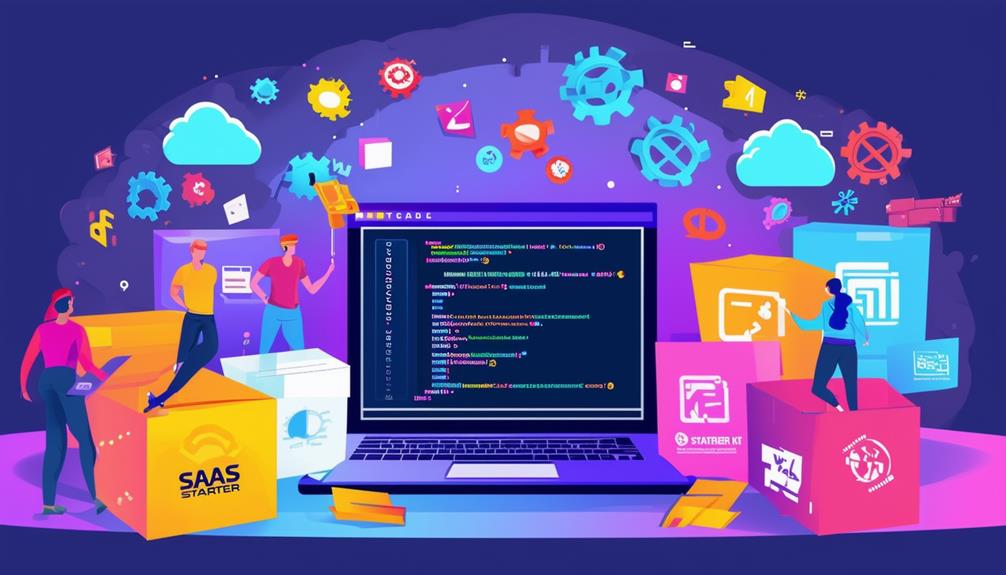When you’re integrating a SaaS boilerplate, the decisions you make upfront can greatly impact your project’s success. Start by choosing a tech stack that fits your team’s expertise and take into account an API-first design to enhance communication between components. Modular architecture can streamline development, while robust authentication methods guarantee security. But there’s more to think about—like how to optimize database integration and maintain consistent versioning. Each step you take lays the groundwork for scalability and performance. Curious about the remaining tips that can elevate your integration process?
Choose the Right Tech Stack
Choosing the right tech stack is crucial for your SaaS project’s success, as it impacts everything from development speed to scalability. Start by identifying your project requirements—think about the features you need, the user experience you want to provide, and the expected traffic. This will help you narrow down your options.
Next, consider your team’s expertise. If your developers are well-versed in a particular language or framework, it might make sense to leverage those skills. Using familiar tools can greatly reduce development time and increase overall productivity.
Also, evaluate the long-term viability of your choices. Opt for technologies that have a robust community and ongoing support, guaranteeing you won’t face challenges down the road.
Don’t forget about integration capabilities. Choose a tech stack that allows for easy integration with third-party services, as this can enhance your application’s functionality without requiring extensive additional development.
Lastly, think about scalability. Confirm that your chosen technologies can grow with your business, accommodating increased user demand without sacrificing performance. By carefully selecting your tech stack, you set your SaaS project up for success.
Modularize Your Architecture
Modularizing your architecture streamlines development and simplifies maintenance, allowing your team to focus on delivering features efficiently while guaranteeing each component can evolve independently.
Break your application down into smaller, manageable modules that encapsulate specific functionality. This approach not only enhances clarity but also makes it easier to test and deploy individual components.
Start by identifying core functionalities and grouping them into distinct modules. For instance, separate user authentication, data processing, and payment gateways into their own modules. This separation of concerns helps in isolating issues and reduces the risk of system-wide failures.
Utilize microservices or serverless architectures to further enhance modularity. By doing so, you allow teams to work on different modules simultaneously, speeding up development cycles. Confirm that each module has a well-defined interface to facilitate communication with other components.
Regularly review and refactor your modules to keep them aligned with your evolving business needs. Encourage your team to document module dependencies and interactions clearly. This practice fosters better understanding and eases onboarding for new developers.
Implement API-First Design
Implementing an API-first design guarantees that your application is built around a robust and flexible interface, allowing for easier integrations and faster development cycles. Start by defining your API specifications before diving into coding. This approach helps make certain all teams understand the requirements and can work in parallel, speeding up the development process.
Use tools like OpenAPI or Swagger to document your API. This documentation acts as a single source of truth, making it easier for developers to understand how to interact with your application. Adopting versioning practices for your API is also vital. As your application evolves, maintaining backward compatibility guarantees ongoing support for existing clients and integrations.
Don’t forget to focus on well-defined endpoints and clear response structures. This clarity helps third-party developers integrate seamlessly without confusion. Additionally, consider implementing rate limiting and caching to optimize performance and manage usage effectively.
Make certain to involve stakeholders in the API design phase. Their feedback can provide valuable insights that improve usability. By prioritizing an API-first design, you set the foundation for a scalable and adaptable application that meets the needs of both users and developers.
Prioritize Authentication Methods
Prioritizing robust authentication methods is vital for guaranteeing the security and integrity of your SaaS application. Start by implementing multi-factor authentication (MFA). This adds an extra layer of security, requiring users to provide additional verification beyond just a password. Encourage users to enable MFA during the registration process to enhance their accounts’ protection.
Next, consider integrating Single Sign-On (SSO) capabilities. SSO simplifies the user experience by allowing users to access multiple applications with just one set of credentials. This not only improves usability but also reduces the likelihood of password fatigue, which can lead to weaker password practices.
It’s also important to regularly review and update your authentication mechanisms. Confirm that your password policies enforce strong, complex passwords and that you’re using secure hashing algorithms to store them. Implement account lockout policies for repeated failed login attempts to protect against brute-force attacks.
Lastly, keep abreast of the latest security trends and vulnerabilities. Regularly evaluate your authentication methods against current best practices to stay ahead of potential threats. By focusing on these strategies, you’ll greatly enhance the security posture of your SaaS application.
Optimize Database Integration
To guarantee your SaaS application runs smoothly, you need to streamline your database integration for best performance and scalability. Start by choosing the right database management system (DBMS) that aligns with your application’s specific needs, whether it’s SQL or NoSQL.
Next, optimize your database schema. Confirm it’s designed for efficiency, with normalized tables to reduce redundancy, but consider denormalization for read-heavy applications when appropriate.
Implement indexing on frequently queried columns to speed up data retrieval, but be cautious not to over-index, as this can slow down write operations.
Utilize connection pooling to manage database connections efficiently, reducing the overhead of establishing connections for each request.
Regularly monitor your database’s performance metrics. Identify slow queries and optimize them with techniques like query refactoring or caching results when applicable.
Lastly, confirm you have a solid backup and recovery plan in place. This isn’t just about performance; it’s about safeguarding your data and maintaining availability.
Utilize Third-Party Services
Leveraging third-party services can greatly enhance your SaaS application’s functionality and speed up development. Instead of building everything from scratch, consider integrating tools that provide essential features like payment processing, user authentication, and analytics. This lets you focus on your core product while guaranteeing that you’re using proven solutions.
Start by identifying the areas where third-party services can add value. For example, if you need payment processing, services like Stripe or PayPal can save you time and effort. For user management, tools like Auth0 streamline authentication and authorization processes, making it easier to manage user data securely.
When selecting third-party services, prioritize those with robust documentation and strong community support. This will help you troubleshoot issues quickly and implement features effectively.
Also, be mindful of the costs associated with these services. Confirm that the pricing model aligns with your budget and growth plans.
Ensure Scalability From Start
Building a scalable architecture from the outset guarantees your SaaS application can handle growth without major overhauls. To achieve this, start by choosing a robust tech stack that supports scalability, such as microservices or serverless architecture. This approach allows you to add or remove resources as needed, making sure performance remains ideal under varying loads.
Next, design your database with scalability in mind. Opt for a database that can handle horizontal scaling, like NoSQL options, which allow for seamless data distribution across multiple servers. Implementing caching strategies can also enhance performance, reducing database load during peak times.
Additionally, use an API-first approach to make certain that your application can integrate easily with other services and scale out its functionality. Consider container orchestration platforms like Kubernetes to manage your application’s growth efficiently.
Monitoring and analytics are vital too. Implement tools to track performance and user engagement, enabling you to identify bottlenecks early and address them proactively. By prioritizing scalability from the start, you’ll save time, costs, and headaches as your SaaS product grows, setting a solid foundation for future success.
Maintain Consistent Versioning
Maintaining consistent versioning across your SaaS application guarantees that all users and integrations are on the same page, minimizing confusion and enhancing compatibility. To achieve this, adopt a clear versioning strategy, such as Semantic Versioning (SemVer), which uses a three-part number system: major, minor, and patch. This approach helps you communicate changes effectively.
When you release a new version, make certain to document the changes thoroughly. Create a changelog that outlines what’s new, what’s fixed, and any breaking changes. This transparency builds trust with your users and helps them adjust to updates seamlessly.
It’s essential to establish a routine for version increments. Set a schedule for regular releases, whether they’re weekly, monthly, or quarterly. This keeps your team on track and allows users to anticipate updates.
Lastly, verify that your APIs reflect the correct versioning. Clearly indicate the version in the API endpoints, making it easy for developers to integrate and adapt.
Monitor Performance Metrics
Monitoring performance metrics is essential for ensuring your SaaS application runs smoothly and meets user expectations. Start by identifying key performance indicators (KPIs) relevant to your service, such as response time, uptime, and error rates. Set up monitoring tools to collect data on these metrics continuously.
Next, analyze the collected data to spot trends or anomalies. If response times spike or error rates increase, you need to investigate potential causes. Regularly review this data to assess your application’s performance over time and make informed decisions about necessary improvements.
Don’t forget to establish benchmarks for your KPIs. This will help you measure success and identify areas needing attention. By comparing your current performance against these benchmarks, you can determine if your application is on track or if adjustments are necessary.
Lastly, create alerts for critical performance issues. This way, you can react promptly to potential problems, minimizing downtime and ensuring a better user experience. By actively monitoring performance metrics, you not only enhance your application’s reliability but also build trust with your users, ultimately driving user retention and satisfaction.
Document Integration Processes
As you track performance metrics, it’s important to document your integration processes to confirm consistency and clarity throughout your development cycle.
Start by outlining each step involved in your integration. This includes data flow, system interactions, and user roles. Use clear language and avoid technical jargon that might confuse your team members.
Next, create standardized templates for your documentation. This guarantees everyone follows the same structure, making it easier to understand and reference. Include diagrams or flowcharts where applicable; visual aids can enhance comprehension and retention.
Make it a habit to update your documentation regularly. Whenever there’s a change in the integration process or technology stack, reflect those changes immediately. This will help you maintain accurate records and avoid confusion later.
To Wrap Up
By following these integration tips for SaaS boilerplates, you can create a robust, scalable application that meets user needs.
Choose a tech stack that fits your team’s skills, modularize your architecture, and implement an API-first design to streamline communication.
Don’t forget to prioritize security, optimize your database, and maintain clear documentation.
Keep an eye on performance metrics and guarantee consistent versioning to enhance user experience.
Start integrating effectively today for long-term success!






